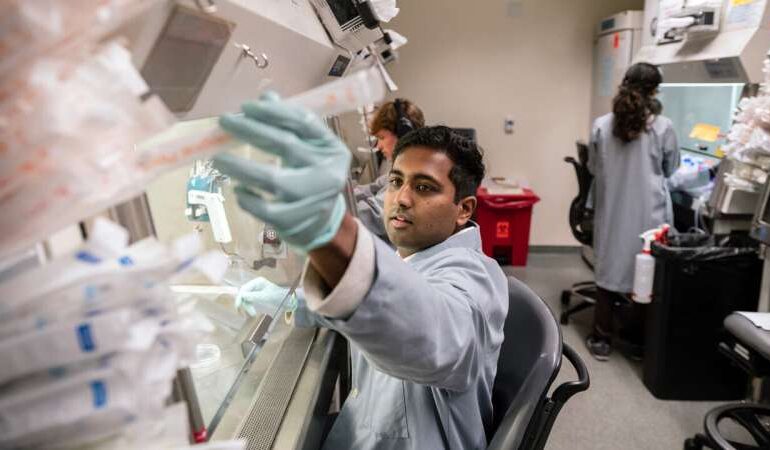Researchers Uncover Distinct Genome Editing Approaches in Neurons

A recent study has revealed significant differences in how neurons and other nondividing cells respond to CRISPR-Cas9 gene editing. This research, conducted by scientists at the Gladstone Institutes in collaboration with the Innovative Genomics Institute and UC Berkeley, highlights the need for tailored approaches in gene editing, especially for treating brain-based genetic disorders. The findings were published in Nature Communications on November 18, 2025.
The CRISPR-Cas9 gene editing tool has revolutionized the treatment of various diseases linked to genetic mutations. Despite its potential, using this technology for brain disorders has posed challenges. According to Bruce Conklin, a senior investigator at Gladstone and the study’s lead author, understanding the DNA repair mechanisms in nondividing cells is crucial. “If we want to ensure genome edits result in the right outcomes, we need to understand and control how the cell’s DNA is repaired after we cut it,” Conklin stated.
Understanding Cellular Responses to Gene Editing
Gene editing involves using the protein Cas9 to cut targeted DNA sequences. In their study, the researchers found that the editing outcomes in neurons differ markedly from those in dividing cells, which have been the primary focus of previous research. Gokul Ramadoss, a Ph.D. candidate in Conklin’s lab and the study’s first author, explained, “Most people studying CRISPR have focused on dividing cells, but it turns out the rules of genome editing are different in nondividing cells like neurons.”
The unique DNA repair mechanisms in neurons lead to different outcomes following the same CRISPR interventions. To explore this, the team developed a method to deliver controlled amounts of CRISPR-Cas9 into neurons. Collaborating with Jennifer Doudna, a Nobel Prize-winning scientist known for her work on CRISPR, they utilized nanoparticles designed to transport gene editing tools safely into cells. This enabled them to investigate neuronal responses to Cas9 cuts effectively.
Prolonged Effects and Predictable Outcomes
The researchers generated neurons from induced pluripotent stem cells (iPS cells), which can be derived from human skin or blood samples. This approach allowed them to compare nondividing neurons with dividing iPS cells that shared the same genetic material. Despite administering the same dose of Cas9, the outcomes varied significantly. The study revealed that Cas9 remained active for a much longer duration in neurons, persisting for up to a month compared to only a few days in dividing cells.
“This could be an important safety consideration,” Conklin noted. The extended presence of Cas9 could increase the likelihood of both desired and undesired edits. Understanding this dynamic is vital for developing safer gene editing therapies.
The study also uncovered that the repair processes in neurons produce more predictable outcomes. When comparing the repaired DNA sequences in both cell types, the researchers observed that neurons exhibited a narrower range of changes, which could lead to more consistent and controlled results. Conklin illustrated this by comparing DNA repair to restoring a damaged artwork, emphasizing the benefits of having a singular expert repairing the damage rather than multiple individuals using various methods.
Remarkably, the research identified that neurons activate specific DNA repair genes previously thought inaccessible to nondividing cells. This discovery opens new avenues for directing gene editing towards more favorable outcomes. “We also showed that these new strategies can be used in other important nondividing cells, including heart muscle cells,” Conklin added.
The researchers have also devised innovative methods to regulate these newly identified repair genes. By creating lipid nanoparticles that deliver gene editing tools alongside molecules that inhibit certain repair genes, they can now make precise cuts in DNA while controlling the repair process.
Ramadoss described this advancement as akin to performing surgery on the genome. “Before, we could make an incision but we couldn’t control how the DNA gets stitched up afterward. With this work, we’re starting to develop the repair tools required to ensure the right editing outcome.”
The platform developed through this research holds promise for applications across various gene-editing proteins, cell types, and diseases. Conklin emphasized the ultimate goal: “Our aim is to precisely control the gene editing process to deliver life-changing therapies. Now, we have important new tools to make sure we get this right.”
This groundbreaking study not only enhances our understanding of gene editing in neurons but also paves the way for safer and more effective treatments for genetic disorders affecting the brain and other nondividing cells.






